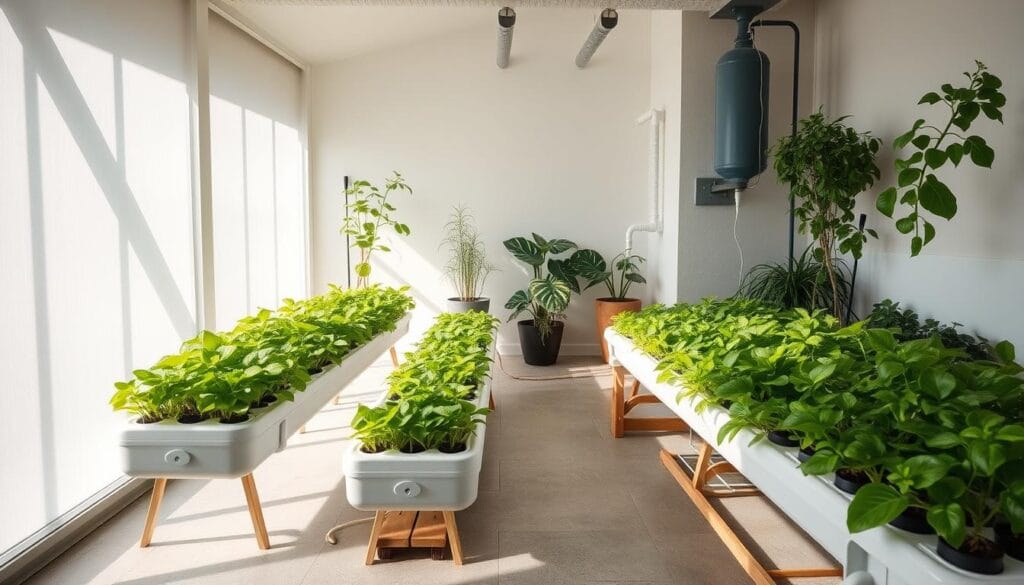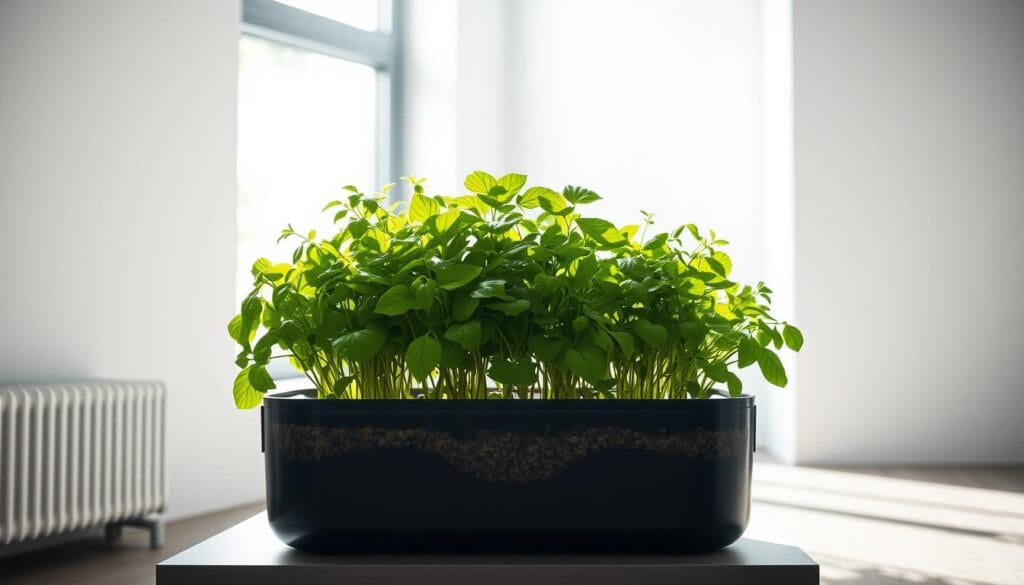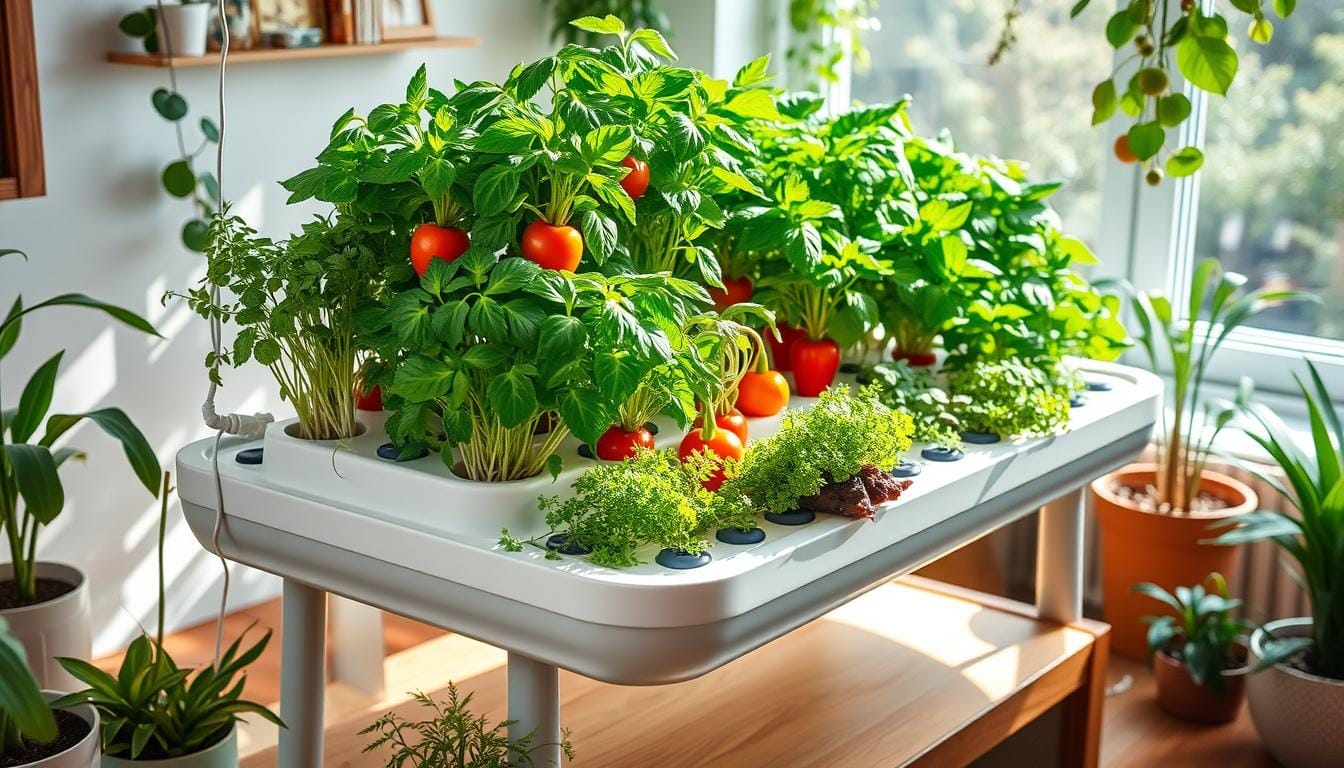The benefits of using a hydroponic planter are transformative, especially for those with limited gardening space. A hydroponic planter allows you to grow plants efficiently indoors, making it an ideal solution for small apartments or urban dwellings. The benefits of using a hydroponic planter include faster plant growth, reduced water usage, and year-round gardening while eliminating the mess and pests associated with soil-based gardening. By replacing soil with nutrient-rich water, these systems optimize plant growth and simplify gardening, making it accessible and enjoyable for everyone.
Key Takeaways
- Hydroponic planters enable efficient, space-saving indoor gardening
- They use significantly less water than traditional soil-based gardening
- Hydroponic systems can produce higher yields and faster growth cycles
- Vertical farming with hydroponics creates a sustainable and compact growing solution
- Hydroponic gardening eliminates the need for harmful chemicals and pesticides
Understanding Hydroponic Growing Systems
Hydroponics offers an innovative method of growing plants without the need for soil. It uses water solutions full of nutrients. This method helps plants grow well indoors, saving space and resources.
Basic Components of a Hydroponic Planter
A hydroponic planter has a few key parts:
- A water reservoir for the nutrient solution
- Grow lights for photosynthesis
- A growing medium like clay pebbles or coco coir for roots
- Water pumps to move the nutrient-rich water
Together, these parts make a soil-free space for plants to grow.
How Hydroponic Systems Work
Hydroponic techniques keep plants’ roots in a water solution full of nutrients. The water moves around, giving plants what they need. This way, plants grow well without soil.
Different Types of Hydroponic Methods
There are many hydroponic methods to try:
- Nutrient Film Technique (NFT): A stream of solution flows over roots
- Ebb and Flow: The tray fills with solution, then drains
- Drip Systems: Solution drips onto roots
- Aeroponics: Roots hang in a nutrient mist
Each method has benefits, depending on the plants and the grower’s needs.
“Hydroponics has the potential to revolutionize the way we approach agriculture, providing a sustainable and efficient solution for food production.” – Dr. Emily Walters, Horticulture Researcher.
Benefits of Using a Hydroponic Planter
Hydroponic planters bring a new level of efficiency to indoor gardening. They use less water and let you grow plants all year, allowing your garden to thrive with less effort.
One big plus is how little water they use. Hydroponics can conserve up to 90% more water compared to traditional soil-based gardens. This is great because farming uses a lot of water, and hydroponics uses much less.
These planters let you grow plants anytime, not just in certain seasons. Your indoor garden can keep producing fresh food, no matter the weather. This means you don’t have to rely on shipping food from far away, which is better for the planet.
Another advantage is how fast plants grow. Hydroponics can make plants grow 25-30% faster than soil gardens. This means you get more food from your garden, making it a smart choice for the future.
Finally, hydroponic planters are good for the environment. They don’t need harmful chemicals because they control pests well. This makes gardeningg healthier and more sustainable for you and the planet.
| Benefit | Impact |
|---|---|
| Water Efficiency | Up to 90% less water usage compared to traditional agriculture |
| Year-Round Growing | Ability to cultivate seasonal foods regardless of weather conditions |
| Faster Plant Growth | 25-30% faster growth due to direct nutrient access |
| Pesticide-Free | Reduced need for harmful chemicals in a controlled environment |
Using hydroponic planters opens up a world of sustainable gardening. You save water, grow plants all year, and get faster growth. Plus, you don’t need to use harmful chemicals, making it better for the planet.
Space-Efficient Indoor Gardening Solutions
Hydroponic planters change the game for indoor gardening, especially in cities where space is tight. They use vertical farming to grow more food in less space. This allows you to maximize the use of every inch of space.
These systems work great on rooftops, in warehouses, or even underground. They’re perfect for urban agriculture. You can grow a garden in the middle of busy cities. This way, you get fresh, local food right at your door.
Vertical Growing Possibilities
Hydroponic vertical farming uses stacked platforms to grow many crops in a small space. This space-efficient design opens up new ways to garden indoors, allowing you to grow a lot of food in a tiny area.
Compact Design for Small Spaces
Traditional gardening takes up a lot of space, but hydroponic planters are different. They’re made for city living and take up much less space. Whether you have a small balcony or a tiny apartment, you can still have a big garden indoors.
Maximizing Growing Areas in Urban Environments
Finding land for farming in cities is hard, but hydroponics offers a solution. You can grow food on rooftops, walls, or indoor spots. This way, you can enjoy fresh produce without being limited by your space.
Water Conservation and Resource Efficiency
Hydroponic gardening is great for saving water and managing resources well. It consumes up to 90% less water compared to traditional farming methods. This is because it recycles water, avoiding loss of evaporation and runoff.
Hydroponic gardens also use fewer resources. Eden Green Technology uses 90% less light energy and 99% less land than traditional farming. This is key to sustainable agriculture as resources become scarcer.
The water in hydroponic systems is purified well. Reverse osmosis removes 98% of all impurities, which is vital in areas where 85% of the water is hard and mineral-rich.
“Hydroponic systems are transforming the way resources are managed in agriculture. They use less water and are more productive in a small space. This is leading to a more sustainable future in food production.”
Hydroponic gardening is also efficient because it’s controlled. It avoids the risks of outdoor growing, such as diseases and pests, leading to healthier plants and more food.

In short, hydroponic gardening is very water-efficient and resource-smart. It’s a good answer to the need for sustainable farming and better resource use.
Faster Growth and Higher Yields
Hydroponic systems are changing how we grow crops. They use optimized nutrient delivery. This makes plants grow 25-30% faster than in soil.
As a result, you get a quicker harvest and more food. This is a big win for farmers and gardeners.
Optimized Nutrient Delivery
The secret to fast growth is how hydroponics delivers nutrients. Plants’ roots soak in a solution full of what they need, helping them grow strong and produce more.
Year-Round Growing Capability
Hydroponics also lets you grow plants all year, no matter the weather. The system keeps plants safe from bad weather. This means you always have fresh food, no matter the season.
Controlled Environment Benefits
This controlled space helps plants grow fast and protects them from weather problems. For example, Eden Green Technology’s greenhouse in Texas grows 5 million pounds of leafy greens yearly, which shows how well-controlled environment agriculture works.
“Hydroponic systems create optimal conditions for plants, leading to faster growth and higher yields that surpass those of traditional soil-based gardening.”
Hydroponics uses optimized nutrient delivery and controlled environments, which means it changes the game for growing crops. It’s leading the way to a more sustainable food future.
No Soil, No Mess: Clean Gardening Experience
Goodbye to the troubles of traditional soil gardening. Hydroponic gardening is a clean and mess-free way to grow food indoors. It does not require soil and avoids soil problems like degradation and diseases.
A hydroponic planter is perfect for many places, like your home or office. It’s great for areas where keeping things clean is key. You won’t have to deal with soil, making gardening easy and fun.
“Hydroponic gardening significantly reduces water consumption, using as much as 90% less water than traditional soil-based gardening methods, making it an exceptionally efficient and eco-friendly approach to growing plants.”
Imagine growing your herbs, greens, and veggies without the mess of soil. Hydroponic systems give plants the nutrients they need right at the roots. This clean indoor farming method requires no harmful chemicals, making gardening better for you and the planet.
Whether you live in the city or love gardening, hydroponic gardening is a smart choice. It lets you have a soil-free garden that’s easy to care for and clean.
Pest and Disease Management in Hydroponic Systems
Keeping your hydroponic garden healthy is key. The controlled environment of hydroponics helps a lot. You can keep your plant health top-notch by using integrated pest management and keeping things sterile.
Natural Pest Control Methods
Hydroponic gardening lets you use natural pest control. You can bring in good bugs like ladybugs to eat pests. Also, using organic stuff like neem oil can keep pests away without harming your plants.
Preventing Common Plant Diseases
Hydroponics makes it hard for diseases to spread. Keeping the right balance of nutrients and water stops many diseases. Monitor your plants carefully and take immediate action at the first sign of any issues.
Maintaining a Sterile Growing Environment
Keeping your hydroponic area sterile is crucial. Clean and sterilize everything often. Watch for any signs of trouble and keep things clean. This way, your garden stays healthy and productive.
Hydroponics makes managing pests and diseases easy. With the right integrated pest management and a clean setup, you can grow great plants indoors—no harsh chemicals are needed.
Cost-Effectiveness and Long-Term Savings
Setting up a hydroponic system initially costs more than traditional gardening. However, the long-term savings and advantages make it a wise and practical investment. Hydroponics are energy-efficient and resource-conscious, cutting down operational costs over time.
Hydroponics also saves a lot of time and effort. Labor costs in vertical farming can be up to 30% lower than traditional agriculture. Modern hydroponic setups are designed to be efficient and automated. This means less time and effort for maintenance, leading to big labor savings.
Moreover, hydroponics is great at saving water and nutrients. It uses about one-tenth the water of traditional farming, which not only cuts down water bills but also helps the environment. Plus, the precise nutrient delivery in hydroponics can reduce nutrient costs by 25% compared to traditional gardening.
With a well-designed hydroponic system, you can have consistent yields all year round. This makes it a cost-effective and profitable choice for your indoor gardening needs.

“Hydroponics can achieve plant densities up to 16 times greater compared to traditional soil-based farming, demonstratingits efficiency and cost-saving potential.”
By choosing hydroponic gardening, you can enjoy lower operational costs, labor savings, and a sustainable investment. These advantages will provide lasting returns over time.
Getting Started with Your Hydroponic Garden
Starting a hydroponic garden is exciting and rewarding. It’s an ideal choice for both experienced gardeners and those just starting. Setting up a hydroponic starter kit lets you explore soil-free gardening. Here’s what you need to know to start your DIY hydroponics project.
Essential Equipment Checklist
Having the right equipment is key to a successful hydroponic garden. Here are the basics you’ll need:
- Water reservoir: This holds the nutrient-enriched water that nourishes your plants.
- Grow lights: Providing the necessary light for photosynthesis, especially for indoor setups.
- Water pump: Circulates the nutrient solution from the reservoir to the plant roots.
- Growing medium: Materials like coco coir, perlite, or vermiculite support the plant roots.
- Nutrient solution: A carefully balanced blend of essential macro and micronutrients.
Setup Guide for Beginners
Beginners should start with simple systems like deep water culture or wick systems. These are easy to care for and don’t require much setup. Follow a step-by-step guide to set up your hydroponic system, fill the reservoir with nutrient solution, and carefully position your plants.
Choosing the Right Plants
Choose beginner-friendly plants like leafy greens, herbs, and small fruiting vegetables. These plants do well in hydroponics and are easy to care for. Start with these to ensure success before moving on to harder plants.
You’ll quickly have a thriving hydroponic starter kit with the right equipment, a good setup, and the right plants. Enjoy the wonders of soil-free gardening and the satisfaction of growing your food.
Conclusion
As cities grow and we face more environmental issues, hydroponic planters are becoming key to sustainable farming and food safety. These systems are great for growing plants indoors. They save space and water and let us grow food all year.
Hydroponics tackles big problems like food shortages and resource wasting. It makes gardening easy and clean for city folks. This method ensures plants get the right nutrients and stay healthy, leading to many tasty, nutritious veggies.
As farming evolves, hydroponics will be vital for growing food in cities. They help make food sustainable, reliable, and easy to get. Adding a hydroponic planter to your home can change how you grow food. It paves the way for a more sustainable and self-reliant future.
FAQ
What are the basic components of a hydroponic planter?
A hydroponic planter has a few key parts. You need a water reservoir, nutrient solution, grow lights, water pumps, and a growing medium.
How do hydroponic systems work?
Hydroponic systems grow plants without soil. They use water rich in nutrients, and plants get the right mix of oxygen, nutrients, and water for growth.
What are the different types of hydroponic methods?
There are many hydroponic systems. Nutrient Film Technique (NFT), Ebb and Flow, Drip Systems, and Aeroponics are popular. Each has its benefits for different crops and growers.
What are the benefits of using a hydroponic planter?
Hydroponic planters save up to 90% of water. They let you grow plants all year. Plants grow 25-30% faster. They also need less pesticides, save space, and give higher yields.
How do hydroponic systems enable space-efficient indoor gardening?
Hydroponics and vertical farming use space well. They can be installed on rooftops, in warehouses, and even underground, making them great for cities.
How do hydroponic systems conserve water and other resources?
Hydroponics uses up to 98% less water than farms. It also saves land and energy, making it a green choice for farming.
How do hydroponic systems contribute to faster growth and higher yields?
Hydroponics gives plants the nutrients they need quickly. This makes plants grow 25-30% faster. You can grow plants continuously throughout the year, unaffected by seasonal changes or weather conditions.
What are the benefits of a clean, soil-free gardening experience?
Hydroponics doesn’t need soil, which means no mess and no soil damage. It also reduces diseases and pests.
How do hydroponic systems manage pests and diseases?
Hydroponics effectively controls pests and diseases, using fewer pesticides. The clean growing space helps prevent diseases, making food safer.
Are hydroponic systems cost-effective in the long run?
Hydroponics might cost more at first. However, they provide long-term financial savings. They use resources wisely and offer steady income, making them a smart investment.
How can I get started with a hydroponic garden?
To start a hydroponic garden, you need some equipment. This includes a water reservoir, nutrient solution, grow lights, water pumps, and a growing medium. Beginners should start with simple systems like deep water culture or wick systems. Growing leafy greens, herbs, and small fruiting plants is a good place to begin.
As cities grow and we face more environmental issues, hydroponic planters are becoming key for sustainable farming and food safety. These systems are great for growing plants indoors. They save space, water, and let us grow food all year.
Hydroponics tackle big problems like food shortages and wasting resources. They make gardening easy and clean for city folks. This method ensures plants get the right nutrients and stay healthy, leading to lots of tasty, nutritious veggies.
As farming evolves, hydroponics will be vital for growing food in cities. They help make food sustainable, reliable, and easy to get. Adding a hydroponic planter to your home can change the way you grow food. It represents progress toward a more sustainable and self-reliant future.

